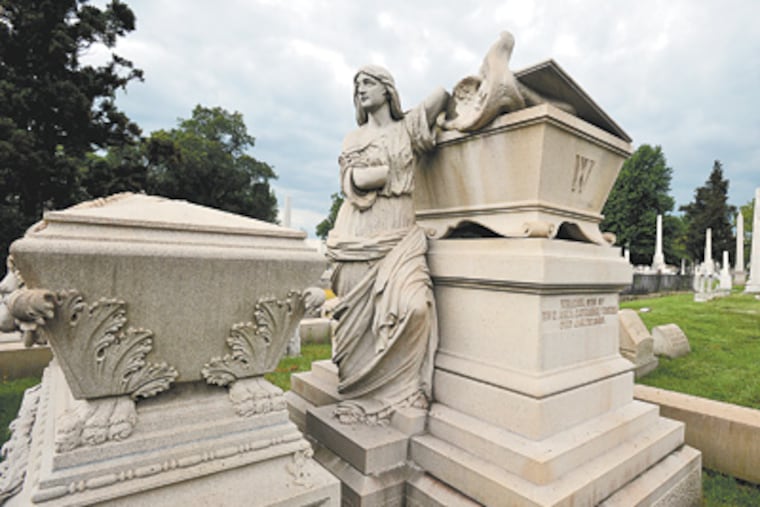The memories will live on in Laurel Hill guidebook
To mark their wedding anniversary, Doug and Audrey Miller of Northeast Philadelphia renewed their sacred vows at one of their favorite spots in the city - among the tombstones at Laurel Hill Cemetery.

To mark their wedding anniversary, Doug and Audrey Miller of Northeast Philadelphia renewed their sacred vows at one of their favorite spots in the city - among the tombstones at Laurel Hill Cemetery.
"We take our 5-year-old daughter there often to spend the day walking and taking pictures. It's such a beautiful place," Audrey Miller said.
"For some of the pictures, we posed in front of a mausoleum overlooking the Schuylkill, and they turned out great."
Miller recently submitted her 2008 photos for publication in a 175th-anniversary book that cemetery officials plan to publish in January.
Called 175 Years of Reflections, the pocket-size guidebook will replicate a few passages from an 1849 guide and contain more recent poems, photos, prints, and written remembrances.
Items submitted by July 30 will be considered for the publication, said Alexis Jeffcoat, program coordinator. Guidelines are available online at thelaurelhillcemetery.org and by telephone at 215-228-8200.
To date, more than three dozen writings and illustrations have been submitted for the book, Jeffcoat said. Among them is an image of a bronze relief created by former Philadelphia sculptor Frederick Osborne for the gravestone of his son, Tom, a young husband, father, and veterinarian who died of a brain tumor in 2005.
Tom Osborne visited the cemetery often, his father said, because a great-great-uncle, an Englishman who died in Philadelphia while visiting the 1876 Exposition, is buried at Laurel Hill.
"It was clear Tom loved that spot near the river," Osborne, former director of Pennsylvania Academy of the Fine Arts, said in a recent telephone interview from his home in Connecticut. "And making the sculpture was part of the grieving process for me."
Laurel Hill, which opened in 1836 and is a National Historic Landmark, is no ordinary burial ground. Designed as a public park with an emphasis on horticulture and history, the cemetery manages to respect the dead while entertaining the living.
A professional archivist is in the final stages of cataloging the site's vast archives. Visitors are welcome during daylight hours, and among the sights is a corpse preserver with an ice chamber and a viewing lid, c. 1871.
Dog-walking is encouraged; a cell-phone tour describes the meaning behind the strange obelisks and urns; the gift shop stocks Death Mints, tombstone-shaped cookie cutters, and a CD commemorating Phillies announcer Harry Kalas, who last year joined the long list of statesmen, Civil War vets, Titanic victims, and everyday Philadelphians entombed here.
A calendar of monthly events features a "Dining With the Dead" dinner; the big annual fund-raiser is called the Gravedigger's Ball; and at last year's 5K Rest In Peace run one participant came dressed as Cruella de Vil from 101 Dalmatians. (Coming up June 11 is Dig In, touted as "A Culinary Tour and Class to Die For.")
"This was intended as a place for the living," says Gwen Kaminski, director of development and programs at the cemetery.
So, she said, it should come as no surprise that a group of female friends gathered at Laurel Hill for a 40th birthday party picnic last year - and one of them just submitted a painting for 175 Years of Reflections.
In March, Wisconsin high school students in town for a band performance visited the cemetery and one student later sent in a poem.
And a Ventnor, N.J., woman whose grandmother is buried at Laurel Hill wrote a piece expressing her regret for not listening to her grandmother's stories and lessons.
"The architecture and its symbolism draws some people," Kaminski says, "but people feel a connection to Laurel Hill for all sorts of reasons."
"I love the history," says Audrey Miller, who is a member of the nonprofit Friends of Laurel Hill. "Cemeteries tell so many different stories."